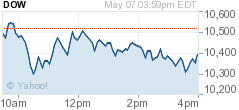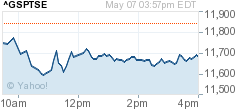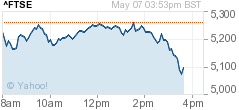Well, today didn’t bring a reprise of yesterday’s excitingly scary equity market crash and whiplash recovery. It wasn’t a quiet day in the markets, although it seemed like it compared to yesterday, but by the end of the day the markets seemed to be leaving us with no clear idea of whether or not they had recovered from an awful week of anxiety. Here’s where the Dow Jones Industrial Average and TSX ended up by the end of the day:


Oh heck, just for fun let’s look at a London chart, because it’s scarier than the North American charts today:

London’s a few hours ahead of North America, in music as in clock time, so its market didn’t have a chance to recover after that ugly-looking selloff you see there at the end of their day. It occurred at the same time as the early day slide in our markets above.
So what did this mean for the ag markets today? Not much. Canola ended the day close to where it began, pushed down by the rising dollar and falling crude oil prices but buoyed a bit by rising soybean and soyoil prices. Enough factors counteracting each other to leave things at a bit of a stalemate.
Ag commodities weren’t brutalized this week the way the world’s equity markets were, so we didn’t see quite the same linkage we did during the collapse days of 2008, when everything moved in lockstep. That didn’t surprise a trader I spoke to this afteroon: “Ags are already bottoming,” he told me. “They didn’t get that big rally the equities did, so they didn’t have far to fall.”
Read Also

Budget seen as fairly solid, but worrying cracks appear
The reaction from the agriculture industry to prime minister Mark Carney’s first budget handed down November 4th has been largely positive.
That’s a bit of good news, if it’s true. The equity markets still look weak going forward but grains and oilseeds shouldn’t be as vulnerable because they didn’t suffer the sense-defying rally that took equities up 60 percent in a year, as if the ruining of the world’s financial infrastructure wouldn’t stop the next multi-year bull market from beginning. Crop prices might look weak now, but if that makes them safe or safer from the contagion of panic that the Greek crisis seems to be creating, then at least their weakness is a hedge against slumping.















